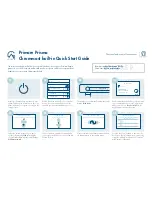Page 4
3 Connecting inputs & outputs
Many problems associated with electronic
equipment involves connecting leads, which are
usually either
‘BAD CONNECTION’ or a
‘WRONG CONNECTION’
. So it’s worth making
sure that you have good connections and that
your leads are the right way round.
Inputs
The amplifier will work with any standard piece of
hi fi e.g. CD, Tuner, Tape Deck, Mini Disc, TV,
Video Recorder, DVD etc having an output of
250mv or more, to get full power.
If you wish to use a turntable you will need a
suitable phono pre-amp. Icon Audio can supply
you. Contact for more information.
The unit will also function as a power
amplifier
. In this mode of operation it is
suggested that the volume control be fully
clockwise, and volume be controlled on the pre-
amplifier for best results. The tape input will
provide the most direct signal path. Good quality
leads should be used, making sure that you have
good connections both ends.
Connecting a tape deck
(or recording device)
The STEREO 20 will playback from virtually any
tape deck having suitable output, but it is not
possible to record through the amplifier. But in this
case you could connect your source direct to the
tape deck and monitor the output from the tape
deck. Or a suitable switch box could be used.
Connecting loudspeakers
The function of speaker cable is to present the
output of the amplifier to the speakers as if the
cable did exist, therefore cables should have the
following properties:
Low resistance, low capacitance, as be as short
as is practical, and be of similar length (up to 33%
variation). Something like QED 79 strand or, or
better. But beware, no cable on earth can make
your system sound ‘better’ than it actually is. It
would be better and may be cheaper to re-arrange
your room and use shorter cables than to spend a
fortune on longer cables!
You can either ‘hard wire’ your cable to the
amplifier by baring enough cable to fit in the
connector and twist together to avoid any spare
strands touching anywhere else.
Be warned this
amplifier does not have an output protection
device, which we consider would degrade the
sound. So a prolonged short due to strands of
wire touching could damage the valves
.
Alternatively use good quality ‘banana’ plugs,
once fitted they are trouble free.
It is essential that you observe the polarity of
the terminals; they must be the same for the
left/right connections at the amplifier end and
at the loudspeaker end
. Otherwise the sound will
be ‘out of phase’ with the sound stage ‘inside out’
with reduced bass.
If you are unable to check or confirm the
polarity
(e.g. if you have ‘built in’ wiring), try the
following; Connect the system up and play some
music with plenty of bass (e.g. dance music),
preferably in mono (FM tuners are usually
switchable to mono) and stand the speakers close
together. If correct you should hear plenty of bass,
if not
reverse the terminals for one channel
only, either at the amp or speaker.
You will now
hear more, or less bass. The higher bass output is
the correct setting to use. Another alternative is to
use a test disc.
The STEREO 20 is designed to work with full
range, medium to high efficiency having
impedance of 4 ohms to 8 ohms. Speakers which
have efficiency of lower than 88db will have
greater difficulty in providing a high sound level.
But this will also depend upon room size, type of
music and positioning.
If your speakers are labelled ‘4 to 8 ohms’ or
similar, this usually means that the speaker has
an 8 ohms midrange and treble unit, but uses a 4-
ohm bass unit to get greater efficiency. The
Stereo 20 has the output optimised for 6 ohms,
which should match virtually all speakers in this
range.
If your speakers are bi-wired the holes in the post
may be used to accommodate either bare wire or
banana plugs.

















